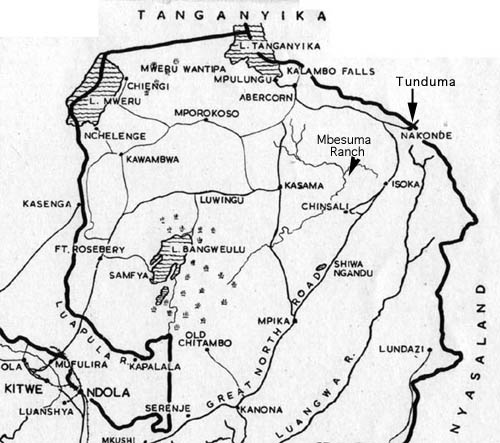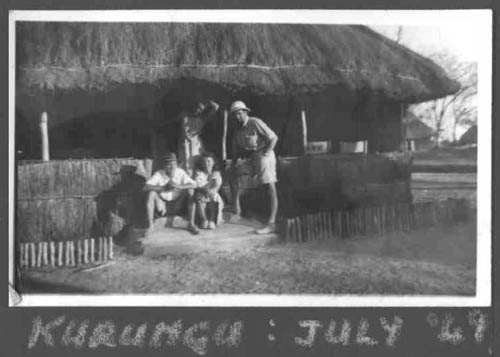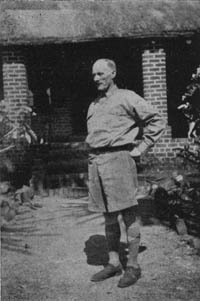Part 1 - Big Game Hunter!
I got my first big rifle when I was
17 years old. It was a .303 Long Lee-Enfield of first war vintage.
It was handed to me by the Kasama DC in 1949 with the instructions
to shoot two tons of game a week to help feed the workers on the
bridge that my father was going to build over the Kalomo river,
between Isoka and Tunduma on the Great North Road.
We had arrived at Kasama after travelling in an old 1939 Ford
Sedan with my mother and sister from Bulawayo. I was recovering
from having been shot in the leg with a shotgun so the prospect
of becoming a 'big game hunter' was none too welcome, but proved
to be one of the most interesting for a long time.

In those days the 40 mile deep border area between Lake Tanganyika
and Lake Nyasa had been declared a Rinderpest clearance area and
all game was considered vermin. No restrictions.
We drove as instructed from Kasama via Mbesuma and Isoka and headed
north to the river. Then we had to drive one mile upstream through
the thick bush until we found a 'red peg' on the bank. And that
was where the bridge was to be!!
We recruited labour, they appeared as if by magic as soon as we
pitched camp, and we set about building a bush house big enough
to accommodate my mother and sister who had stayed in Kasama until
it was finished. It took about ten days.

We were there for about 9 months and I did provide meat for over
500 workers, many of them women who 'washed' sand for concrete
by swilling it around in the water. Rock was broken by hand after
being reduced in size by building fires to heat it the having
water thrown on it. Primitive.. but it worked. Shuttering timber
was cut in the bush and sawn with pitsaws, a man in a pit below
and another standing on the log above.
Enough of the construction. The people we met while we were there
were some of the characters of the old bush.
Mr Rumsey at Mbesuma ranch had been there for more than twenty
years rearing cattle which he and his partner had 'trekked' twice
a year down to the 'line of rail' at Broken Hill, over 200 miles
South. In the 30's his partner had had a 'dangling' hand licked
by a lion while sleeping at the Lua Lua hotel in Kasama.This had
left him with a deformed hand, pinched up like a claw.

Frank Rumsey at Mbesuma about
1938 - Photo W V Brelsford - NR Journal
Rumsey looked like a bank clerk but was a hard experienced bush
hand. One evening when we were dining there he had a call from
one of his workers. He politely excused himself and went out.
Half an hour later he returned with apologies. He had just shot
his 300th lion. Although in his seventies he had cycled half a
mile to his cattle kraal, shot the lion inside, and returned to
finish his meal with us!!
Rumsey had a part time 'lodger'. Captain Langham had been for
many years Elephant Control Officer in the Luangwa Valley and
had hand-drawn maps of a large area with clusters of iether red
or blue crosses marked. The red crosses were the Elephant he had
shot for the government and the blue ones were his 'private' bag.
Captain Langham's problem was that after most of the year in the
Luangwa he emerged at the beginning of the rains with his haul
of ivory which he sold and then went on a binge until he got DT's
and was hospitalised. He had done this for years but Mr Rumsey
tried to stop the pattern and allowed him to stay at Mbesuma as
long as he stayed off the drink. It worked for a few years but
eventually after retiring from the elephant hunting, Langham returned
to his old ways and finished up in an old folks home in Ndola.
Another family had a ranch not far from 'our' bridge. The family
Jeffries (Jeffrys ?) lived some miles off the GNR along a track
which grew over each year and the small wooden bridges were often
under water. There were two sons who helped me a lot with their
experience all their lives of living and hunting in the bush.
The whole family semed to love their remote lives without any
of what most people would consider necessary civilised comforts.
Radio/ fridges/gas cooking/running water and toilets etc. The
sons went off to the copperbelt when they were old enough, but
only to earn money to buy implements and farming equipment. I
often wonder what happened to such hardy dedicated working folk
in all the changes that came later.
At Tunduma on the Tanganyika border was a small rest house run
by a Mrs Green, living with her small son. Their life was simply
to look after the very few europeans who might want to stay for
a night or two. We did stay sometimes when going to Mbeya. I wonder
if Mbeya has yet got a railway to go to the Victorian (or German
?) style grand station building.
South of us was the boma at Isoka with its DC and a policeman.
At that time he was Harry Arrigoni who seemed to spend most of
his time 'working out' with giant logs carved like dumbells. He
had magnificent muscles but we found that he could not apply them
and at times could hardly support his own weight when faced with
things like climbing and carrying things.
Isoka is on a very steep hill from the high plateau above and
while we were there a giant Fiat lorry with trailer, many of which
had been plying from East Africa to South Africa for years, lost
its brakes on the way down and at the bottom struck a 3ft across
eucalyptus tree, snapped it off, and cartwheeled to finish up
on top of the tree.
We had quite a few visits from the White Father missionaries,
Katibunga mission I think and they were wonderful people who gave
so much of practical help to the local villagers and were lovely
comppanions whenever they visited. Father Empter and Corbeil are
the ones I remember best.
That was the area where I got my grounding in bush life. There
was so much more to follow and so many more interesting people.
Sir Stewart Gore-Browne at Shiwa, also Doctor Glynn and Margaret
Scott there, A P Marriot and George Watts at Mpika, The Gamwell
sisters, Doctor Trant and others. I've thrown a few names in in
the hope that they might bring back some memories of anyone there
in those days.
Roy Williams